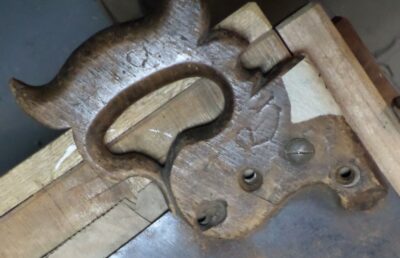SawWorks I – Buying
I read recently that my old friend and Martin Donnelly auction companion Josh Clark is dispersing Tom Law’s inventory of saws. I did not know Tom well but I always tried to find a few minutes to chat with him during the PATINA annual tool extravaganza. He knew more about saws in his pinkie finger than almost any woodworkers know in their whole bodies and was an indefatigable rescuer and rehabilitator of old saws. In a way it does not surprise me that his inventory was roughly one thousand saws at the time of his death. It makes my “collection” of two dozen carpenter’s handsaws puny by any comparison.
All of the saws in my “collection” are or will be working saws, most that I have purchased at tool swaps and the like. I have an approach to selecting a vintage saw for use (or gifting) with the menu of features including the following.
Saws Are Like Pizza

This is a near-perfect candidate for my own tool kit. The plate is heavy, the tip is nearly 3″ wide, indicating it has not been re-toothed, the surface rust is pretty minor (the pitting after cleaning will be minor), and the planarity is nearly perfect. The slight flattening and sharpening will be demonstrated in coming posts. Plus, it was only five bucks at a MWTCA shindig.
Like pizza a vintage saw plate better have lotsa meat. I like saw plates that have not been used or sharpened a lot, definitely not re-toothed. I like them to be not only thick in gauge but also as wide as possible. In other words, in “as new” configuration even if not in “as new” condition.
No Bad Skin Cancer
A little surface rust is fine, maybe even a little more than that, providing the overall strength/integrity of the plate is intact. It only takes me a minute to determine whether the surface can be polished enough to make the tool work smoothly.
Unlike Elected Officials, No Kinks
I know that real saw maestros can reclaim a badly bent saw plate, but I do not possess the skill nor the desire to do so. I don’t mind a teensy bit of bend in the plate, providing it is not literally creased, but a gentle level of un-planarity can be addressed easily and quickly. There are many videos on-line to show how this is done, the best one for me is Bob Rozaieski’s video.
He’s The One With A Full Set Of Teeth.
Many years ago I was trying to identify one of the colorful local fellows to Mrs. Barn, and I was getting nowhere with my attempt. Old guy. White beard. Glasses. Baseball cap. I was having no luck sparking her memory as that list describes 90% of the men in the region. Then I latched on to the descriptor that prompted her memory. “He’s the one with a full set of teeth.” Immediately she knew who I was talking about.
That also describes what I want when buying a vintage hand saw. All the teeth, in good condition. It’s okay if they need sharpening, but they all gotta be there and in good overall shape. Once you master saw sharpening it becomes quite pleasurable to do.
No Need for a Handle

The handle is of little importance to me. If it is in nice condition and a configuration I want that’s fine. The saw handle in this image was somehow married, and mutilated in the matchmaking, to the plate it was on when I got this saw (all the nut holes were wallowed out to somehow “fit” the holes in the plate). What was once a very nice handle has been ruined and ready for the kindling pile.
Making a saw handle is actually a lot of fun and can be a great act of creativity using a piece of wood you want and your own hand as the template.
If a saw meets these criteria, I’m good to go provided the price is right.


Join the Conversation!